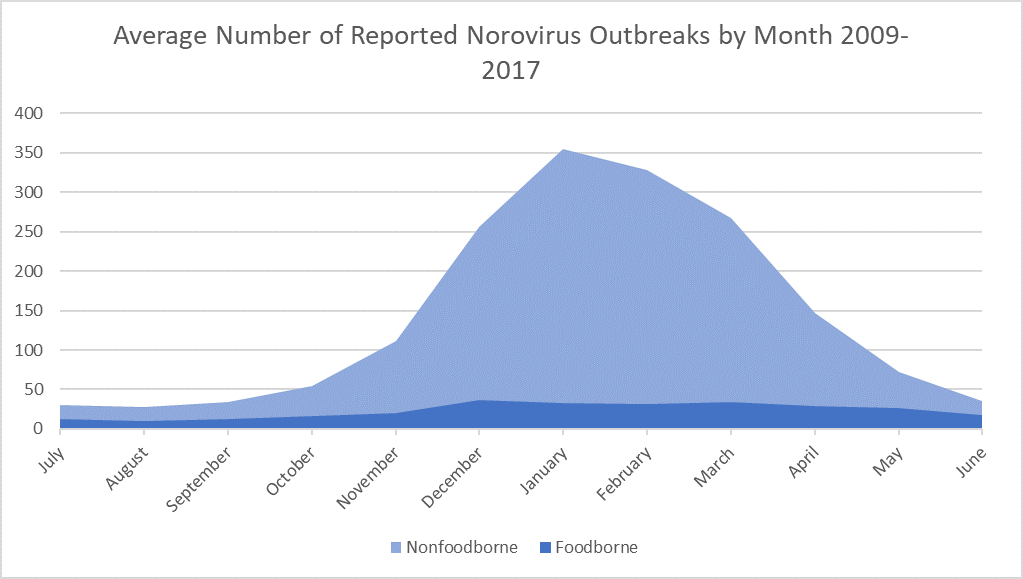Key points
- Norovirus is the leading cause of vomiting and diarrhea from acute gastroenteritis among people of all ages in the United States.
- Each year, there are about 2,500 reported norovirus outbreaks in the United States.
- Norovirus causes 58% of foodborne illnesses acquired in the United States.

U.S. data
Norovirus is the leading cause of vomiting and diarrhea from acute gastroenteritis among people of all ages in the United States. Gastroenteritis is the inflammation of the stomach and intestines.
Norovirus is also the leading cause of foodborne illness in the United States. It causes 58% of foodborne illnesses acquired in the United States.
Annual number of illnesses and associated outcomes
Each year in the United States, norovirus causes on average:
- 900 deaths, mostly among adults aged 65 and older
- 109,000 hospitalizations
- 465,000 emergency department visits, mostly in young children
- 2,270,000 outpatient clinic visits annually, mostly in young children
- 19 to 21 million illnesses
Economic impact
Each year, foodborne norovirus illness in the United States costs about $2 billion, mainly due to lost productivity and healthcare expenses.
Who is affected
Norovirus is responsible for nearly 1 million pediatric medical care visits annually.
People more likely to have an outpatient or emergency department visit than people of other ages:
- Children under 5 years old
- Adults 85 years and older
By 5 years of age:
- 1 in 110,000 will die from norovirus
- 1 in 160 will be hospitalized
- 1 in 40 will go to the emergency department
- 1 in 7 will go to an outpatient clinic
U.S. outbreaks
Each year, there are about 2,500 reported norovirus outbreaks in the United States.
- Norovirus outbreaks occur throughout the year but are most common from November to April.
- In years when there is a new strain of the virus, there can be 50% more norovirus illness.
- Most outbreaks occur when infected people spread the virus to others through direct contact (such as caring for them, sharing food, or eating utensils with them).

Norovirus worldwide
Worldwide, norovirus causes about 1 out of every 5 cases of acute gastroenteritis that leads to diarrhea and vomiting.
Worldwide, norovirus annually causes on average:
- 685 million total cases of acute gastroenteritis
- 200 million cases in children under 5 years old
- 50,000 child deaths, mostly in developing countries
Economic impact
Norovirus illness is a problem in both low-income and high-income countries. Every year, norovirus is estimated to cost $60 billion worldwide due to healthcare costs and lost productivity.
Global outbreaks
Globally, norovirus is the leading cause of acute gastroenteritis outbreaks.
Outbreaks are usually more common in cooler winter months. They typically occur from November to April in countries above the equator; and from May to September in countries below the equator. However, in places closer to the equator, norovirus may be less seasonal.
- Since 2002, GII.4 viruses (genogroup II genotype 4) have caused the majority of norovirus outbreaks worldwide.
- However, non-GII.4 viruses, such as GII.17 and GII.2, have temporarily replaced GII.4 viruses in several Asian countries.
- Between 2002 and 2012, new GII.4 viruses emerged about every 2 to 4 years, but since 2012, the same virus (GII.4 Sydney) has been the dominant strain worldwide. Often, but not always, these new strains lead to a global increase in norovirus outbreaks.

